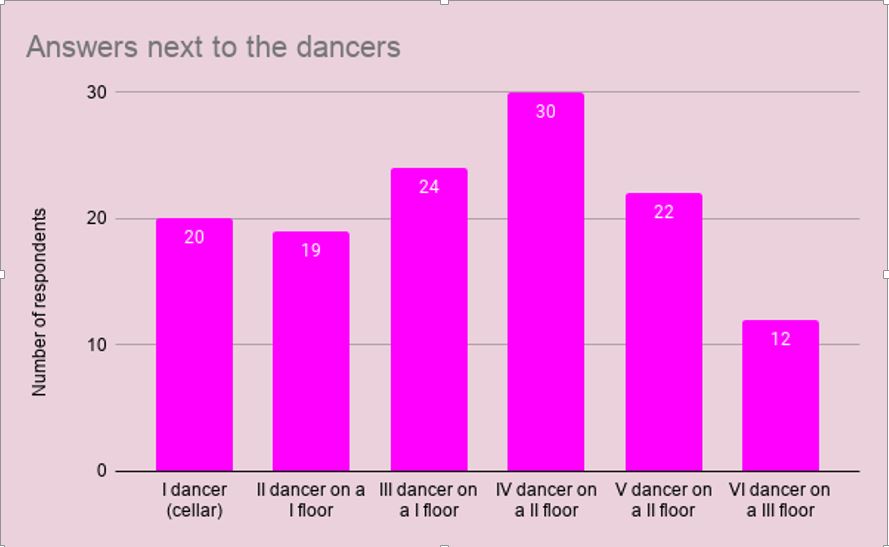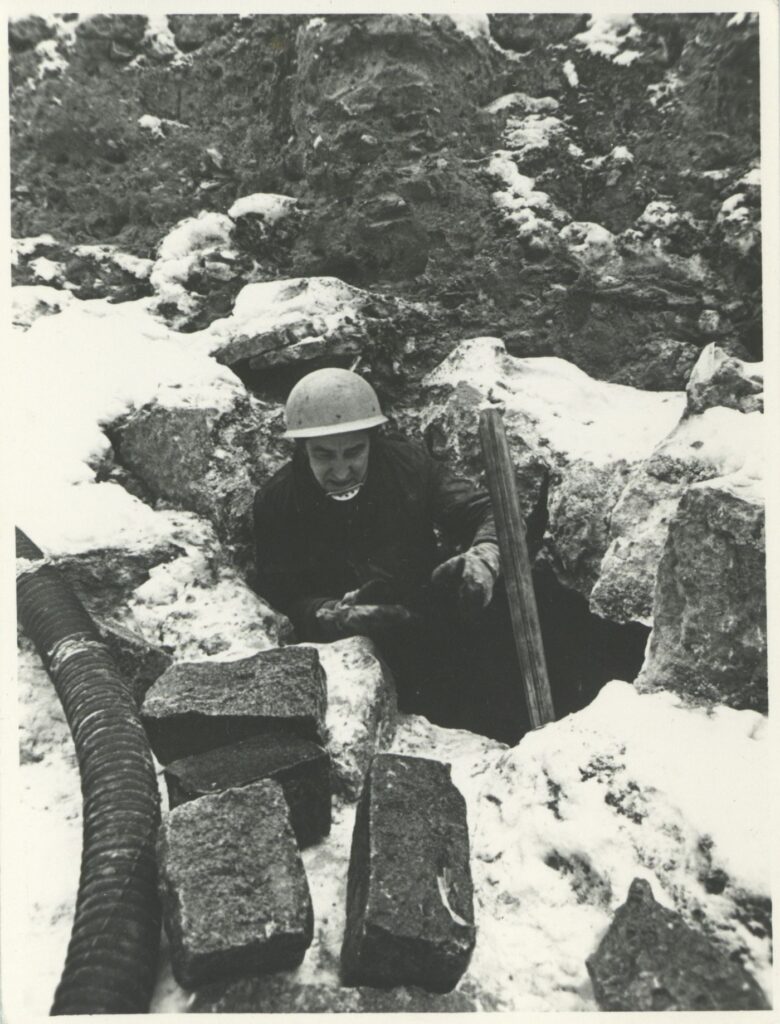Author: Küllike Tint
Tallinn City Museum held a dance performance “One object, many stories”, which focused on exhibiting archaeological artifacts in a slightly untraditional way. Usually we can see objects behind a glass display, but for this performance the “dividing screen” between dancers and visitors was lost during the show. The performance, that took place on September 27–29, was a kind of a small exhibition where the dancers embodied the archaeological finds displayed next to them, presenting various stories about the making, use, beliefs, as well as new ways of use of the objects with short repeatable scenes. The visitor was able to move around the room, just like they would during a regular visit to the museum.
The aim of the performance
The main aim for the performance was to encourage visitors to think about what was on display and share their opinions. Six dancers performed across the museum, and there were multiple-choice answer sheets placed next to the dancers, so that visitors could first write down their thoughts while watching the dance and then read the information from the leaflets. In reality, it didn’t quite work out that way; there were visitors who just enjoyed the charm of dance, there were those who were watching the dance, reading information and filling pages all at the same time, there were also those who passed the dancer a little bit startled. Nevertheless, it is good to note that out of 119 visitors 30 visitors, so at least 25%, shared their thoughts, which means that a good proportion of museum visitors wanted to be actively involved in the programme.

The subject matter of the performance
The main idea of the performance was to focus solely on the importance of the archaeological context – to explain through examples how the surroundings of the find help to identify the function or use of the object. For example, based on what can it be said that the coin was used as a piece of jewelry, as sacrifice or just as means of payment. In particular, we would have liked to use objects which function has been altered over time, such as a clay pipe, which is now used as a whistle instead. As we wanted to connect the merchant’s house, exhibitions and the artefacts from the archaeological collection of City Museum at the same time, fulfilling the first idea turned out to be a bit complicated and in the selection of objects and themes we based on the room and exhibitions instead. In addition to the aforementioned, we decided to experiment with smells that could contribute to the interpretation of objects and dance, but we should have announced this connection to the visitors more.
Themes:
1. The well.
The History of the use of the well in the exhibition of Tallinn City Museum.
In addition, mold odor was applied here.
Dancer Susanna Kinnunen.




Thoughts from Susanna:
”The performance in Tallinn City Museum was an educational and unique working experience for me. I was performing at a well inside the museum. In the past, this well used to be an important place to get water and later it was used as a trash pit. In my performance, I was depicting some actions that people might have done at this historical site from my own imagination. As a dancer and person who is interested in history it was quite eye-opening and educational to put and imagine myself bodily and emotionally in a position of a person from the past. How would have a young woman like me felt on a sunny day when she was getting the water? What kind of movements and feelings somebody might have done while tossing away stuff they don’t need anymore? These thoughts gave me a new layer to the dance. The well was located in the cellar of the museum and visitors found their way down quite unevenly. Sometimes I was dancing long for only one person who was interested, sometimes I was dancing for myself and at times there were many people at the same time. There were some people who would start dancing the same dance with me, some came close and some stayed at a distance, but we shared an eye-contact. These experiences felt very special. I think very dearly about the One Object, Many Stories – performance, I was surrounded by kind visitors and museum staff and an interesting, inspiring historical site.”
2. Ceramics.
How one potsherd can provide important and versatile information from the past (creation, trade, food storage).
The dance took place in diele’s kitchenette, where meals were made in metal or ceramic three-legged pots on an open fire under a mantelpiece. They also experimented with the smell of fire here. Dancer Kärt Kurvits.




3. Various uses of coins
(means of payment, offering, adornment).
The dance took place in diele’s merchant’s representative office room where financial and economic procedures were done. Dancer Kirsi Mari Lepik.




4. The change in the function of the stone axe over time
The dance took place on the second floor at the cultural showcase. For a more playful blog post, there’s a video of the stone axe dance, in which everyone can reflect on what is depicted in the dance. The dancer presents the story of the object with short scenes. When one feature / story changes, the dancer signals it with a clap. Video montage – Küllike Tint. Dancer Ingrid Elsa Mugu.
Thoughts from Ingrid:
„I remember feeling very grateful that I can be a part of a project with so awesome and pleasant artists and people. I remember that for me it was interesting to be in a situation where I was in “my own room” but at the same time available and even slightly vulnerable for the audience. And it was also fascinating to find a way to get out of the uncertainty that some of the reactions of the audience might have created, while still remaining within my main activity – storytelling.”
5. The symbol of the cross in time
The dance took place at the showcase of the Pirita and Dominician monastery. Dancer Mikko Turpeinen.



6. The interpretation of objects – horse
The dance took place on the third floor “From stronghold to town. The birth of the Danish town 800 years ago” exhibition room. The performance used the horse-shaped weights found from Toompea in the 13–14 century and the horse pendulum found from Dunkri street, exhibited in the exhibition. Dancer Lisa Giebel.



7. Archaeology in the city
Not all the people can make it to the museum, and in order for the wider public to be able to see the event, we brought the museum and the archaeology itself into the cityscape. Vanaturu junction was chosen as the location, which associated well with Tallinn 800 theme year. Due to the location, historians have offered various hypotheses to Vanaturu kael throughout times – it is thought that it was the site of the Battle of Lyndanis in 1219; it has also been suggested that the place was a hub and shopping centre for various roads even before the conquest of the Danes. 1977. a former Museum archaeologist, Kaupo Deemant, carried out excavations there. The medieval finds of which explained that it was not an Ancient market place nor a battleground; but a well was found from the site – the existance of which was actually already known before. The well was probably built before the Tallinn water supply system (15th century) and was initially still used for waterboarding, but the 16–18 century finds with defects (pieces of mud shoes, parts of leather shoes and objects) prove that during some time period, it functioned as a rubbish hole, which was actually quite common in the case of medieval wells.
Artifacts from the archaeological excavations of Vanaturg. Photos: Meeli Küttim





In the show, the dancers were in 2×2-meter pole-capped ” pits.” The right location of the real mine and the well were a few metres towards Karja Street, as can be seen from the graphic by Gehlhaar Theodor, but due to external terraces, this chosen place was more suitable at the time.
Dancers Ida Teeri and Nelli Ojapalu.





Thoughts from Nelli:
“It was really interesting to be in the middle of the town square doing something extraordinary. People stopped to watch and some tried to mask their watching into taking photos or looking past us. We got our own space by just having a different energy from the people passing us. Of course there were those who tried to come and join us. But actually I was expecting there to be more interference. So these few encounters were actually a surprise. I liked bringing movement to the scenery that probably doesn’t get it that often. I was glad to be outside in the fresh air and meet a lot of a people, tourists and locals. I think it is very important that different fields of art (museum and contemporary dance) make collaborations and interact with each other. It brings so much diversity and complexness to the work that we do. And also that the science (archaeology) comes to the scenery as well. It is important that we support each other and create new connections. Otherwise we can’t evolve or learn and figure out what new there is to be discovered.”
Why dance and archaeology?
Interdisciplinarity, or interweaving of sciences is necessary in archaeology, because it is not possible to answer all the questions yourself. Thus, scientists from other specialties, such as geneticists and osteologists for examining past people, often collaborate. It’s actually the same with exhibiting archaeology – being behind glass in a normal exhibition format can only attract a smaller number of visitors. Involving other specialties, there are more approaches and different perspectives in exhibiting objects, which can make the museum more approachable for the visitor, raise more questions or attract attention. Although dance is very different from archaeology, they still have some similarities. Objects have always been connected to people, and the choreography retains that physical human entity in the museum object. Studying or reconstructing the past and objects requires the opinion and imagination of an archaeologist. It’s the same with a dancer who contributes his fantasy, movement and emotion to telling a story.
Although the event only took place once, the video footage can certainly be used in other programmes and expositions in the future.
A summary video of the performance is here:
Event execution:
The subject matter: Küllike Tint & Suvi Tuominen
Choreographer: Suvi Tuominen
Texts and objects: Küllike Tint
Text design: Lilian Juhkam
Dancers:
(FIN) Mikko Turpeinen, Ida Teeri, Nelli Ojapalo, Susanna Kinnunen
(EST) Ingrid Elsa Mugu, Kärt Kurvits, Kirsi-Mari Lepik
(GER) Lisa Giebel
Photos and filming: Marko Mikael Marila
Scents: Aroomiturundus OÜ
Supporters of the project:


Words of appreciation to:
Nadežda Saar
Kristiina Johanon
Meeli Küttim,
Anu Lõhkivi,
Merle Petersoo,
Johanna Rannula,
Anne Rahusaar
To the volunteers who participated in the event: Ando Pajus, Triin Siiner, Ene Heimvel, Kristiina Hiiesalu, Tina Timonen, Jelena Tšekulajeva, Made Isak, Hendrik-Julius Kits, Toomas Abiline, Merike Neidorp, Eero Väin, Peeter Talvar, Triinu Tuvi, Aet Laast, Aime Tahvonen, Julia Voinova.
The greatest thanks to the dancers and Suvi who agreed to go along with this project!
More information:
https://www.facebook.com/events/583585858712596/?active_tab=discussion
https://linnamuuseum.ee/cat-linnamuuseum/uks-ese-mitu-lugu/


